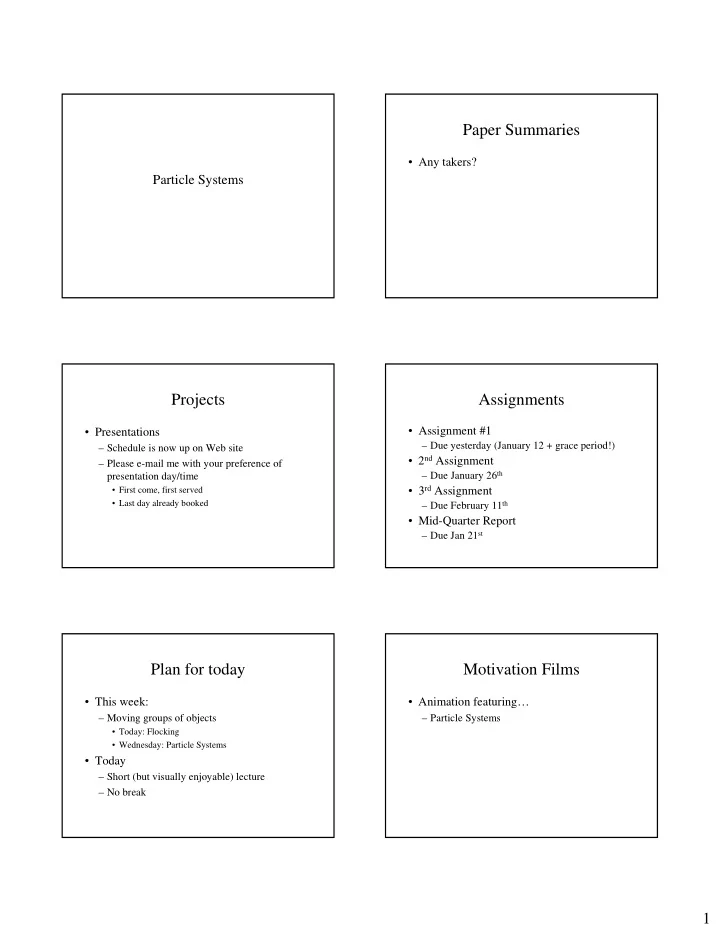

Paper Summaries • Any takers? Particle Systems Projects Assignments • Assignment #1 • Presentations – Due yesterday (January 12 + grace period!) – Schedule is now up on Web site • 2 nd Assignment – Please e-mail me with your preference of – Due January 26 th presentation day/time • 3 rd Assignment • First come, first served • Last day already booked – Due February 11 th • Mid-Quarter Report – Due Jan 21 st Plan for today Motivation Films • This week: • Animation featuring… – Moving groups of objects – Particle Systems • Today: Flocking • Wednesday: Particle Systems • Today – Short (but visually enjoyable) lecture – No break 1
Motivational Film Motivational Film • Particle Dreams (1988) • Genesis Sequence (1982) – Karl Sims – From Star Trek II: The Wrath of Khan – Between playing with genetics, Sims was – Williams Reeves programming Particle Systems on his CM-2 – Origin of the term “particle systems” Connection Machine – First use of particle systems • 64K 1 bit processors – Notice names in credits Plan For Today Particle Systems • Topics • A means for of modeling fuzzy objects, such as fire, clouds, smoke, water, etc. – Particle Systems – Don’t have smooth well-defined surfaces – non-rigid objects • Term coined by William Reeves who first used particle systems in “Star Trek II” Particle Systems Particle Systems • Modeling • Advantages 1. An object is not represented by a set of 1. Complex systems can be created with little primitive surface elements, but as clouds of human effort. primitive particles that define its volume. 2. The level of detail can be easily adjusted. 2. A particle system is not a static entity, its particles change form and move. 3. An object represented by a particle system is not deterministic, its shape and form is not completely specified. Stochastic! 2
Particle Systems Particle Generation • Basic Model • Generated using a controlled stochastic 1. New particles are generated process 2. Each new particle is assigned its own set of attributes • Each particle will come from an emitter 3. Any particles that have existed for a predetermined time are destroyed – Has a number of particles 4. The remaining particles are transformed and moved – Random number of particles/frame according to their dynamic attributes 5. An image of the remaining particles is rendered – Randomize initial values of each particle Let’s go through each step in turn Particle Generation Particle Generation • Emitters at certain locations – Fixed (Water spraying from hose) – Distributed • Designate emitters on surface or in 3D space – Semi-random • Designate center of emitter distribution • Emitters randomly distributed about the distribution center Particle Attributes Particle Termination • Usually assigned using controlled randomness • When a particle’s lifetime is – Initial position up, a particle must be – Initial velocity (both speed and direction) terminated and removed – Initial size from simulation – Initial color • Lifetime usually given in – Initial transparency frames – Shape – Mass – Lifetime 3
Particle Termination Particle Termination • For efficiency’s sake – Create a pool of particles – Not all particle in pool are “alive” at a given frame – Reuse particle after they’ve been terminated • Particle reincarnation! Particle Motion Particle Motion • Collisions • Particles are guided by simple dynamical – Particles will collide with environment simulation – Particles do not collide with other particles – F = MA – A = acceleration (initial push, gravity, etc) • Forces – V = current velocity = dt * A + V prev – Gravity – Wind forces – X = current position = dt * V + X prev – Damping – Vortices / Force Fields – Collisions – Whatever might be appropriate Particle Rendering Particle Rendering • Particle’s color and transparency can be a • Particle is modeled as a point light source function of: – No physical geometry – Time – Do not reflect light – Lifetime left – Adds color to pixel (based on – Height transparency/color) • Particle shape can be a function of • Particles only cast shadows on objects in – Velocity environment, not each other – Can use lines to model motion blur 4
Particle Rendering Particle Independence • In gaming systems, • One reason particle systems is so attractive is that each particle is treated independently – Particles are very often rendered as square or triangle parallel to view plane of every other – Texture map with transparent background – Lends itself to a parallel implementation Group behavior Group behavior • Particle Systems is just one example of group Group Elements Physics Intelligence behavior. • Which also includes Particles many – Particle Systems – Flocks – Autonomous Behavior Flocks some • Difference is in the amount of physics vs. intelligence which control the object motion. Autonomous few – We’ve definitely crossed the line into AI. Behavior Enough Talk Particle System Effects • Let’s see this in action • Grass, Smoke, fire, clouds, water – Applet • Fireworks, explosions • Fluid flow • Physical simulations 5
Particle System Effects Particle System Effects: Explosion • Examples – From Nan’s 1996 CGII Web page Particle System Effects: Water Particle System Effects: Comet Particle System Effects: Deathstar Particle System Effects: Fire 6
Particle System Effects: Fire + Smoke Particle System Effects: Forcefield Writing Particle Systems Questions • Discussion • As promised – Gamasutra Article – No break today • Code – Particle System API (C++) • Next time: – Game Developer Web site (July 1998) – Hierarchical Models and animation 7
Recommend
More recommend